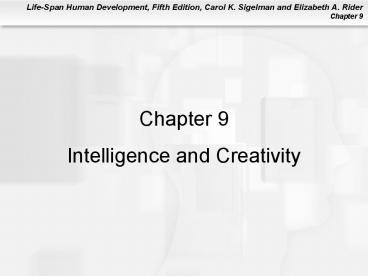Chapter 9 – Intelligence and Creativity - PowerPoint PPT Presentation
1 / 32
Title:
Chapter 9 – Intelligence and Creativity
Description:
Chapter 9 Intelligence and Creativity Chapter 9 Intelligence and Creativity What is intelligence? Adaptive thinking or behavior (Piaget) Ability to think ... – PowerPoint PPT presentation
Number of Views:92
Avg rating:3.0/5.0
Title: Chapter 9 – Intelligence and Creativity
1
Chapter 9Intelligence and Creativity
2
Chapter 9 Intelligence and Creativity
- What is intelligence?
- Adaptive thinking or behavior (Piaget)
- Ability to think abstractly, solve problems?
(Sternberg) - Genetics x Environment
- (interaction)
3
Theories and Tests of Intelligence
- IQ tests
- Intelligence quotient (IQ) tests attempt to
measure an individuals probable performance in
school and similar settings.
Binet (1857-1911) and Simon created 1st IQ ?
test in 1905
4
Theories and Tests of Intelligence
- The Stanford-Binet test
- The Stanford-Binet test - V (2-85)
- The mean or average IQ score for all age groups
is designated as 100 15 (85-115). - Given individually
5
Normal Distribution
Normal Distribution
6
(No Transcript)
7
Individual Intelligence TestsThe Wechsler Scales
- Overall IQ and also verbal and performance IQs.
- (WPPSI-III) Wechsler Preschool and Primary Scale
of Intelligence-Revised. Ages 2 ½ to 7 years, 3
months - (WISC-IV) Wechsler Intelligence Scale for
Children-Revised. Ages 6 to 16 years, 11 months - (WAIS-III) Wechsler Adult Intelligence
Scale-Revised - Ages 16-89
8
WPPSI
WPPSI-III
9
(No Transcript)
10
(No Transcript)
11
WISC-IV
- Word Reasoningmeasures reasoning with verbal
material child identifies underlying concept
given successive clues. - Matrix Reasoningmeasures fluid reasoning a
(highly reliable subtest on WAIS III and
WPPSIIII) child is presented with a partially
filled grid and asked to select the item that
properly completes the matrix. - Picture Conceptsmeasures fluid reasoning,
perceptual organization, and categorization
(requires categorical reasoning without a verbal
response) from each of two or three rows of
objects, child selects objects that go together
based on an underlying concept. - Letter-Number Sequencingmeasures working memory
(adapted from WAISIII) child is presented a
mixed series of numbers and letters and repeats
them numbers first (in numerical order), then
letters (in alphabetical order). - Cancellationmeasures processing speed using
random and structured animal target forms (foils
are common non-animal objects).
12
Theories and Tests of Intelligence
- Ravens Progressive Matrices
- Psychologists created culture-reduced tests
without language. It tests abstract reasoning
ability (non-verbal intelligence or performance
IQ)
13
- Figure 9.2 Items similar to those in Ravens
Progressive Matrices test. The instructions are
Each pattern has a piece missing. From the eight
choices provided, select the one that completes
the pattern, both going across and going down.
(You can check your answers against answer A on
page 339.)
14
The Psychometric Approach
- Intelligence -
- A single attribute?
- Spearman (1863-1945)
- 2 factor theory of intelligence
- g general ability
- s special abilities
15
- Figure 9.3 According to Spearman (1904), all
intelligent abilities have an area of overlap,
which he called (for general). Each ability
also depends partly on an s (for specific)
factor.
16
- Figure 9.4a Measurements of sprinting, high
jumping, and long jumping correlate with one
another because they all depend on the same leg
muscles. Similarly, the g factor that emerges in
IQ testing could reflect a single ability that
all tests tap.
17
- Many attributes?
- Thurstone 7 primary mental abilities
- Spatial ability, perceptual speed, numeric
reasoning, verbal meaning, word fluency, memory,
inductive reasoning
18
What is Intelligence?
- Fluid intelligence and crystallized intelligence
- Cattell Horn believed that the g factor has
two components - - Fluid intelligence is the power of reasoning,
solving unfamiliar problems, seeing relationships
and gaining new knowledge - - Crystallized intelligence is acquired knowledge
and the application of that knowledge to
experience.
19
Concept Check
- A 16-year-old is learning to play chess and is
becoming proficient enough to be accepted into
the schools chess club. Is this fluid or
crystallized intelligence?
20
Concept Check
- Ten years later, the chess player achieves
grandmaster status. Is this a result of fluid or
crystallized intelligence?
21
Gardners Multiple Intelligences
22
- Savant Syndrome
- condition in which a person otherwise limited in
mental ability has an exceptional specific skill - Calculation abilities
- Drawing
- Musical
23
Sternbergs Triarchic Theory
- Contextual Component (street smarts or
practical) - Adapting to the environment
- Experiential Component (creative)
- Response to novelty
- Automatization
- Componential Component (academic or analytical)
- Information processing
- Efficiency of strategies
24
- Figure 9.2
25
- TABLE 9.2 Four theories of intelligence
26
The Infant
- Developmental Quotients (DQ)
- Bayley Scales Ages 2-30 months
- Correlations with Child IQ low to 0
- Useful for diagnostic purposes
- Best predictors
- From measures of information processing
- E.g., attention, speed of habituation, preference
for novelty
27
The Child
- DQ does not predict later IQ
- IQ gains
- Parents foster achievement
- Neither strict nor lax parenting
- IQ drops Poverty
- Cumulative deficit hypothesis
28
The Adolescent
- Brain growth spurt at age 11/12 (puberty)
- Formal operational thinking
- Improved memory and processing skills
- Stability of IQ evident
- IQ score a good predictor of school achievement
- .50 correlation between IQ score and grades
- Adolescents with high IQ less likely to drop out
of high school and more likely to go to college
29
The Adult
- Strong relationships between
- IQ and occupational prestige
- IQ and job performance
- IQ and good health/longevity
30
Mental Retardation
- Below-average intellectual functioning IQ 75
- Limited adaptive behavior before age 18
- Self-care and social skills
- Below age-appropriate expectations
- Causes
- Organic e.g., Down syndrome
- Cultural-familial genes environment
31
The Dynamics of Intelligence
32
(No Transcript)






























